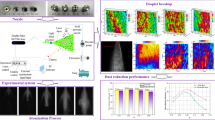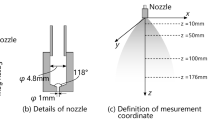Abstract
In this study, the variations of spray characteristics are tested with air-assisted siphon type different size liquid atomizers. The spray characteristics are analyzed considering three atomizers having the same inlet diameter, with different constricted areas and exit diameters for the flow rates of 42, 57, and 71l pm. Three different mixtures of Oleic Acid with Ethanol, and three different mixtures of Di-Octyl Phthalate (DOP) with Ethanol are employed as working fluids along with the six different suction heights. Experimental outcomes show that, for the same flow rates, solution, and suction height, the droplet size changes by varying the diameter of the constricted area and exit area. The change of any area in atomizer changes the level of turbulence in flow that results in the variation of droplet size and its distribution. The increasing flow rate also assists in increasing the droplet size. Since the droplet size distribution decreases with the increasing viscosity, the use of DOP and Ethanol mixture increases the droplet size as it is more viscous than the Oleic Acid and Ethanol mixture. It is also noticed that at a constant airflow rate, Number Median Aerodynamic Diameter (NMAD), and liquid consumption rate are inversely proportional, whereas the Geometrical Standard Deviation (GSD) and Mass Median Aerodynamic Diameter (MMAD) is directly proportional to the suction height.

















Similar content being viewed by others
Data Availability
all the data can be provided upon the request of the reviewers.
References
Akhter MS (1999) Design, development and performance studies on an improved virtual impactor type aerosol generation system. Phd Thesis, IIT, Kharagpur, India.
Ashgriz N, Yarin A (2011) Capillary instability of free liquid jets. Handbook of atomization and sprays. Springer, Berlin, pp 3–53
Chen SK, Lefebvre AH (1994) Spray cone angles of effervescent atomizers. Atomization Sprays 4(3).
Cloupeau M, Prunet-Foch B (1994) Electrohydrodynamic spraying functioning modes: a critical review. J Aerosol Sci 25(6):1021–1036
Das BK, Hoque N, Mandal S, Pal TK, Raihan MA (2017) A techno-economic feasibility of a stand-alone hybrid power generation for remote area application in Bangladesh. Energy 134:775–788
Gao Y, Deng J, Li C, Dang F, Liao Z, Wu Z, Li L (2009) Experimental study of the spray characteristics of biodiesel based on inedible oil. Biotechnol Adv 27(5):616–624
Hewitt AJ (2008) Spray optimization through application and liquid physical property variables–I. Environmentalist 28(1):25–30
Hinds WC (2012) Aerosol technology: properties, behavior, and measurement of airborne particles. Wiley, Hoboken
Jayasinghe S, Edirisinghe M, Wang D (2004) Controlled deposition of nanoparticle clusters by electrohydrodynamic atomization. Nanotechnology 15(11):1519
Jedelsky, J., Jicha, M., & Slama, J. (2004). Characteristics and behaviour of multi-hole effervescent atomizers. Paper presented at the Proc ILASS-Europe.
Jedelsky J, Landsmann M, Jicha M, Kuritka I (2008) Effervescent atomizer: influence of the operation conditions and internal geometry on spray structure; study using PIV-PLIF. Proc. ILASS
Jiang C, Xu H, Srivastava D, Ma X, Dearn K, Cracknell R, Krueger-Venus J (2017) Effect of fuel injector deposit on spray characteristics, gaseous emissions and particulate matter in a gasoline direct injection engine. Appl Energy 203:390–402
Kim D, Martz J, Violi A (2016) Effects of fuel physical properties on direct injection spray and ignition behavior. Fuel 180:481–496
Lefebvre AH (1989) Atomization and sprays. Hemisphere Pub. Corp, New York, p 1989
Mitchell J, Snelling K, Stone R (1987) Improvements to the vibrating orifice aerosol generator. J Aerosol Sci 18(3):231–243
Panchagnula MV, Sojka PE (1999) Spatial droplet velocity and size profiles in effervescent atomizer-produced sprays. Fuel 78(6):729–741
Patterson, M. A., & Reitz, R. D. (1998). Modeling the effects of fuel spray characteristics on diesel engine combustion and emission (0148–7191)
Payri F, Bermudez V, Payri R, Salvador F (2004) The influence of cavitation on the internal flow and the spray characteristics in diesel injection nozzles. Fuel 83(4):419–431
Peters TM, Chein H, Lundgren DA, Keady PB (1993) Comparison and combination of aerosol size distributions measured with a low pressure impactor, differential mobility particle sizer, electrical aerosol analyzer, and aerodynamic particle sizer. Aerosol Sci Technol 19(3):396–405
Rodney C (2004) Scientific American Inventions and Discoveries, 380. Wiley, Hoboken
ScienceDaily (2020). Density. sciencedaily.com. https://www.sciencedaily.com/terms/density.htm#:~:text=Density%2520is%2520a%2520measure%2520of%2520mass%2520per%2520volume.,substance%2520(such%2520as%2520water). Accessed July 10 2020
Sutherland J, Sojka PE, Plesniak MW (1997) Ligament-controlled effervescent atomization. Atomization and Sprays, 7(4).
Toolbox, E. (2020). Ethanol - density and specific weight. The Engineering Toolbox. https://www.engineeringtoolbox.com/ethanol-ethyl-alcohol-density-specific-weight-temperature-pressure-d_2028.html Accessed July 10 2020.
Vanderpool R, Lundgren D, Kerch P (1990) Design and calibration of an in-stack low-pressure impactor. Aerosol Sci Technol 12(2):215–224
Zhang XS, Li LG, Deng J, Huang CJ, Yu S (2007) An experimental study of Bio-diesel spray characteristics. Transactions of CSICE, 2, 012
Acknowledgments
The support of the Heat Engine Laboratory of Rajshahi University of Engineering & Technology (RUET), Rajshahi, Bangladesh, is gratefully acknowledged; in particular, authors acknowledge the Department of Mechanical Engineering, RUET, for required support.
Funding
This work was partially funded by the Department of Mechanical Engineering, Rajshahi University of Engineering and Technology (RUET), Rajshahi, Bangladesh, and the rest part of the money was carried by the first and fourth authors.
Author information
Authors and Affiliations
Contributions
MRIS and MMR have set up the experiment and collected the data. MSR has analyzed the data and helped in manuscript writing. SM has reviewed the manuscript.
Corresponding author
Ethics declarations
Conflict of interest
The contents of this article are not submitted or published anywhere else, and there is no conflict of interest in this whole study. All the authors are willingly submitting this work for their journal.
Rights and permissions
About this article
Cite this article
Sarker, M.R.I., Rahman, M.S., Mandal, S. et al. A Study on Aerosol Spray Characteristics of Different Size Atomizers. Aerosol Sci Eng 4, 306–319 (2020). https://doi.org/10.1007/s41810-020-00076-0
Received:
Revised:
Accepted:
Published:
Issue Date:
DOI: https://doi.org/10.1007/s41810-020-00076-0




